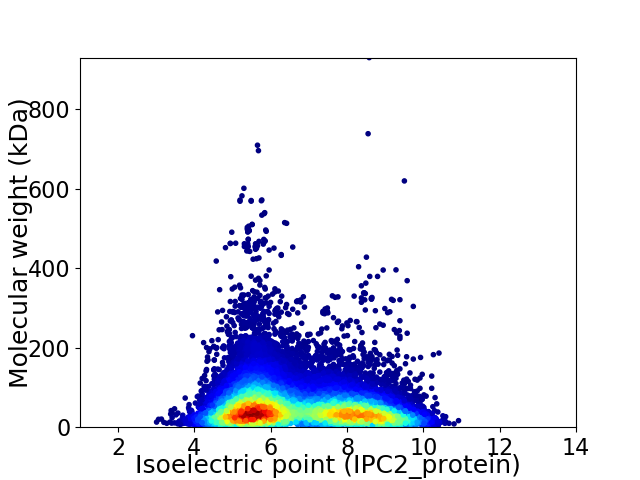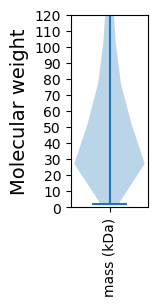
Camelus dromedarius (Dromedary) (Arabian camel)
Taxonomy: cellular organisms; Eukaryota; Opisthokonta; Metazoa; Eumetazoa; Bilateria; Deuterostomia; Chordata; Craniata; Vertebrata; Gnathostomata; Teleostomi; Euteleostomi; Sarcopterygii; Dipnotetrapodomorpha; Tetrapoda; Amniota; Mammalia; Theria; Eutheria; Boreoeutheria; Laurasiatheria;
Average proteome isoelectric point is 6.72
Get precalculated fractions of proteins

Virtual 2D-PAGE plot for 31080 proteins (isoelectric point calculated using IPC2_protein)
Get csv file with sequences according to given criteria:
* You can choose from 21 different methods for calculating isoelectric point
Summary statistics related to proteome-wise predictions



Protein with the lowest isoelectric point:
>tr|A0A5N4EH79|A0A5N4EH79_CAMDR Neuropeptide-like protein C4orf48-like protein OS=Camelus dromedarius OX=9838 GN=Cadr_000002377 PE=4 SV=1
MM1 pKa = 7.86GINNNGDD8 pKa = 3.42SDD10 pKa = 3.98VDD12 pKa = 3.74DD13 pKa = 5.19GGGHH17 pKa = 7.05DD18 pKa = 4.47EE19 pKa = 4.6SDD21 pKa = 3.09ATRR24 pKa = 11.84DD25 pKa = 3.7SEE27 pKa = 4.5VDD29 pKa = 3.19GGGDD33 pKa = 4.55DD34 pKa = 5.34GNDD37 pKa = 3.48DD38 pKa = 3.98GDD40 pKa = 3.57AVMVVKK46 pKa = 9.94MIVVVVMVMVMVMVMSVIITEE67 pKa = 4.46HH68 pKa = 5.8WCPGTVLWAFYY79 pKa = 9.62TRR81 pKa = 11.84AHH83 pKa = 6.67ISLLYY88 pKa = 9.91PYY90 pKa = 9.12EE91 pKa = 3.89QAFTGGG97 pKa = 3.38
MM1 pKa = 7.86GINNNGDD8 pKa = 3.42SDD10 pKa = 3.98VDD12 pKa = 3.74DD13 pKa = 5.19GGGHH17 pKa = 7.05DD18 pKa = 4.47EE19 pKa = 4.6SDD21 pKa = 3.09ATRR24 pKa = 11.84DD25 pKa = 3.7SEE27 pKa = 4.5VDD29 pKa = 3.19GGGDD33 pKa = 4.55DD34 pKa = 5.34GNDD37 pKa = 3.48DD38 pKa = 3.98GDD40 pKa = 3.57AVMVVKK46 pKa = 9.94MIVVVVMVMVMVMVMSVIITEE67 pKa = 4.46HH68 pKa = 5.8WCPGTVLWAFYY79 pKa = 9.62TRR81 pKa = 11.84AHH83 pKa = 6.67ISLLYY88 pKa = 9.91PYY90 pKa = 9.12EE91 pKa = 3.89QAFTGGG97 pKa = 3.38
Molecular weight: 10.4 kDa
Isoelectric point according different methods:
Protein with the highest isoelectric point:
>tr|A0A5N4D2Y1|A0A5N4D2Y1_CAMDR Uncharacterized protein OS=Camelus dromedarius OX=9838 GN=Cadr_000018541 PE=4 SV=1
MM1 pKa = 7.54SGLPGKK7 pKa = 10.35SKK9 pKa = 10.75AGRR12 pKa = 11.84RR13 pKa = 11.84AYY15 pKa = 9.31TKK17 pKa = 10.5AHH19 pKa = 6.78RR20 pKa = 11.84KK21 pKa = 8.87PSISKK26 pKa = 9.82VILGIVAEE34 pKa = 4.27KK35 pKa = 10.29GARR38 pKa = 11.84NRR40 pKa = 11.84VSLATLKK47 pKa = 10.76KK48 pKa = 10.28AIATRR53 pKa = 11.84GYY55 pKa = 11.49NMTRR59 pKa = 11.84NAWRR63 pKa = 11.84FKK65 pKa = 10.15RR66 pKa = 11.84VLRR69 pKa = 11.84GLVDD73 pKa = 3.63KK74 pKa = 11.36GMLKK78 pKa = 10.17QVTGKK83 pKa = 10.22GASASFLMVKK93 pKa = 10.3KK94 pKa = 10.16NASKK98 pKa = 10.43FRR100 pKa = 11.84LKK102 pKa = 10.61AKK104 pKa = 9.6RR105 pKa = 11.84LQRR108 pKa = 11.84RR109 pKa = 11.84RR110 pKa = 11.84QPGQRR115 pKa = 11.84QPGQRR120 pKa = 11.84RR121 pKa = 11.84LLRR124 pKa = 11.84GSKK127 pKa = 9.47QGHH130 pKa = 5.62KK131 pKa = 10.38RR132 pKa = 11.84LIKK135 pKa = 10.08GVRR138 pKa = 11.84RR139 pKa = 11.84MAKK142 pKa = 9.55CRR144 pKa = 11.84RR145 pKa = 11.84SS146 pKa = 3.21
MM1 pKa = 7.54SGLPGKK7 pKa = 10.35SKK9 pKa = 10.75AGRR12 pKa = 11.84RR13 pKa = 11.84AYY15 pKa = 9.31TKK17 pKa = 10.5AHH19 pKa = 6.78RR20 pKa = 11.84KK21 pKa = 8.87PSISKK26 pKa = 9.82VILGIVAEE34 pKa = 4.27KK35 pKa = 10.29GARR38 pKa = 11.84NRR40 pKa = 11.84VSLATLKK47 pKa = 10.76KK48 pKa = 10.28AIATRR53 pKa = 11.84GYY55 pKa = 11.49NMTRR59 pKa = 11.84NAWRR63 pKa = 11.84FKK65 pKa = 10.15RR66 pKa = 11.84VLRR69 pKa = 11.84GLVDD73 pKa = 3.63KK74 pKa = 11.36GMLKK78 pKa = 10.17QVTGKK83 pKa = 10.22GASASFLMVKK93 pKa = 10.3KK94 pKa = 10.16NASKK98 pKa = 10.43FRR100 pKa = 11.84LKK102 pKa = 10.61AKK104 pKa = 9.6RR105 pKa = 11.84LQRR108 pKa = 11.84RR109 pKa = 11.84RR110 pKa = 11.84QPGQRR115 pKa = 11.84QPGQRR120 pKa = 11.84RR121 pKa = 11.84LLRR124 pKa = 11.84GSKK127 pKa = 9.47QGHH130 pKa = 5.62KK131 pKa = 10.38RR132 pKa = 11.84LIKK135 pKa = 10.08GVRR138 pKa = 11.84RR139 pKa = 11.84MAKK142 pKa = 9.55CRR144 pKa = 11.84RR145 pKa = 11.84SS146 pKa = 3.21
Molecular weight: 16.49 kDa
Isoelectric point according different methods:
Peptides (in silico digests for buttom-up proteomics)
Below you can find in silico digests of the whole proteome with Trypsin, Chymotrypsin, Trypsin+LysC, LysN, ArgC proteases suitable for different mass spec machines.| Try ESI |
 |
|---|
| ChTry ESI |
 |
|---|
| ArgC ESI |
 |
|---|
| LysN ESI |
 |
|---|
| TryLysC ESI |
 |
|---|
| Try MALDI |
 |
|---|
| ChTry MALDI |
 |
|---|
| ArgC MALDI |
 |
|---|
| LysN MALDI |
 |
|---|
| TryLysC MALDI |
 |
|---|
| Try LTQ |
 |
|---|
| ChTry LTQ |
 |
|---|
| ArgC LTQ |
 |
|---|
| LysN LTQ |
 |
|---|
| TryLysC LTQ |
 |
|---|
| Try MSlow |
 |
|---|
| ChTry MSlow |
 |
|---|
| ArgC MSlow |
 |
|---|
| LysN MSlow |
 |
|---|
| TryLysC MSlow |
 |
|---|
| Try MShigh |
 |
|---|
| ChTry MShigh |
 |
|---|
| ArgC MShigh |
 |
|---|
| LysN MShigh |
 |
|---|
| TryLysC MShigh |
 |
|---|
General Statistics
Number of major isoforms |
Number of additional isoforms |
Number of all proteins |
Number of amino acids |
Min. Seq. Length |
Max. Seq. Length |
Avg. Seq. Length |
Avg. Mol. Weight |
|---|---|---|---|---|---|---|---|
16143790 |
18 |
22339 |
519.4 |
57.74 |
Amino acid frequency
Ala |
Cys |
Asp |
Glu |
Phe |
Gly |
His |
Ile |
Lys |
Leu |
|---|---|---|---|---|---|---|---|---|---|
7.311 ± 0.015 | 2.227 ± 0.01 |
4.728 ± 0.009 | 7.072 ± 0.019 |
3.597 ± 0.011 | 6.766 ± 0.02 |
2.57 ± 0.007 | 4.067 ± 0.014 |
5.352 ± 0.017 | 10.401 ± 0.02 |
Met |
Asn |
Gln |
Pro |
Arg |
Ser |
Thr |
Val |
Trp |
Tyr |
|---|---|---|---|---|---|---|---|---|---|
2.102 ± 0.007 | 3.258 ± 0.01 |
6.45 ± 0.024 | 4.79 ± 0.012 |
5.979 ± 0.014 | 8.185 ± 0.015 |
5.164 ± 0.009 | 6.222 ± 0.012 |
1.294 ± 0.005 | 2.46 ± 0.009 |
Most of the basic statistics you can see at this page can be downloaded from this CSV file
Proteome-pI is available under Creative Commons Attribution-NoDerivs license, for more details see here
| Reference: Kozlowski LP. Proteome-pI 2.0: Proteome Isoelectric Point Database Update. Nucleic Acids Res. 2021, doi: 10.1093/nar/gkab944 | Contact: Lukasz P. Kozlowski |
